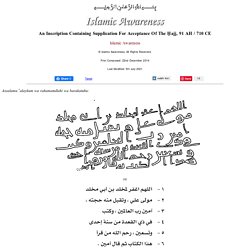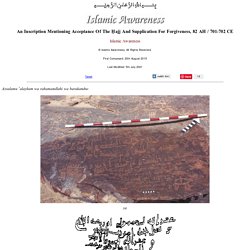

Le tombeau de Khadidja avant sa destruction. Le tombeau d'Eve avant sa destruction en 1913 à Jedda. Dinar représentant le calife Abd al-Malik (696) Le Dôme du Rocher. Le Dôme du Rocher à Jérusalem. Inscriptions préislamiques évoquant le hajj 3. An Inscription Commemorating The Ḥajj Of The Umayyad Caliph Sulaymān Ibn ʿAbd al-Malik, 97 AH / 715-716 CE Islamic Awareness © Islamic Awareness, All Rights Reserved.

First Composed: 27th June 2021 Last Modified: 8th July 2021 Assalamu ʿalaykum wa rahamatullahi wa barakatuhu: Inscriptions préislamiques évoquant le hajj 2. An Inscription Containing Supplication For Acceptance Of The Ḥajj, 91 AH / 710 CE Islamic Awareness © Islamic Awareness, All Rights Reserved.

First Composed: 22nd December 2014 Last Modified: 5th July 2021. Inscriptions préislamiques évoquant le hajj. An Inscription Mentioning Acceptance Of The Ḥajj And Supplication For Forgiveness, 82 AH / 701-702 CE Islamic Awareness © Islamic Awareness, All Rights Reserved.

Rituels hajj 2. Kaaba. Rituels hajj. Départ du mahmal d'Egypte vers la Mecque (2e moitié du XIXe siècle) Mahmal ottoman. La procession du mahmal au Caire. Futuh al haramayn 1597 Istanbul Nuruosmaniye. Cadeaux La Mecque. Affiche pèlerinage La Mecque Algérie. Untitled. Untitled. Nouvelle carte précise de l'Arabie, de la Turquie asiatique, etc. Atlas Miller (1519) Indigenous Boats: What's a Dhow? Good question.

According to Clifford W. Hawkins, in his nicely illustrated book The Dhow: an illustrated history of the Dhow and its World, the term is mainly a European word that seems to encompass just about all of the medium and large indigenous sailing craft of the Indian Ocean, including those of Arab, Persian, and Indian derivation, and more lately including motor-sailing and pure power craft as well. Jordan’s Hejaz Railway depicts an Ottoman legacy. The Jordanian Hejaz Railway, which connects Damascus and Amman to Medina in Saudi Arabia, is a historic example of Ottoman creativity that has made the spiritual journey easier for Muslim pilgrims.

The Hejaz railway line is one of the oldest in the region and the world. It was built in 1902 during the reign of Ottoman Sultan Abdul Hamid II and has allowed pilgrims to drastically cut down their travel time. Before the railway project became operational, the trip used to take three months, but it now takes only 54 hours. Salah al-Lozi, director of the Jordanian Hejaz Line Foundation, told Anadolu Agency that the "railway line is the legitimate and heir son of the Ottoman Empire and the Turkish Republic. " "Since the establishment of the line, its main goal has been to save time and effort for Muslim pilgrims," al-Lozi said. Untitled. Lazarets.
Camel Caravan of Pilgrims To Mecca 1910 Photo Print for Sale. This picture taken on May 24, 2020 during the early hours of Eid... Photo d'actualité. Le pèlerinage à La Mecque : une industrie sous contrôle.